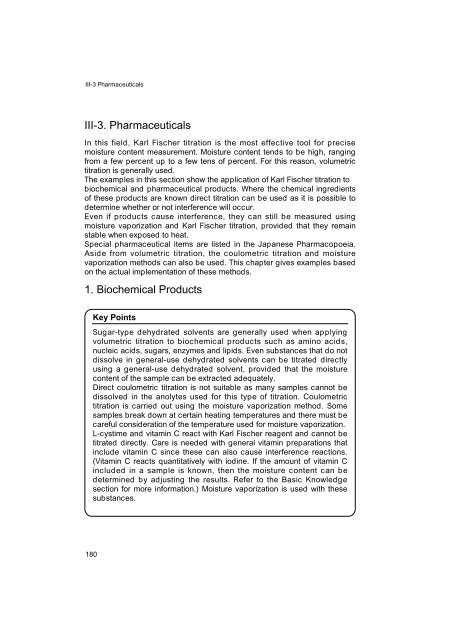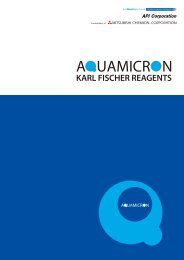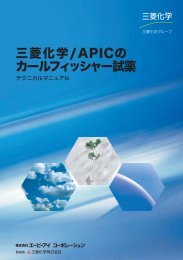Development of Karl Fischer Reagents
Development of Karl Fischer Reagents
Development of Karl Fischer Reagents
Create successful ePaper yourself
Turn your PDF publications into a flip-book with our unique Google optimized e-Paper software.
III-3 Pharmaceuticals<br />
III-3. Pharmaceuticals<br />
In this field, <strong>Karl</strong> <strong>Fischer</strong> titration is the most effective tool for precise<br />
moisture content measurement. Moisture content tends to be high, ranging<br />
from a few percent up to a few tens <strong>of</strong> percent. For this reason, volumetric<br />
titration is generally used.<br />
The examples in this section show the application <strong>of</strong> <strong>Karl</strong> <strong>Fischer</strong> titration to<br />
biochemical and pharmaceutical products. Where the chemical ingredients<br />
<strong>of</strong> these products are known direct titration can be used as it is possible to<br />
determine whether or not interference will occur.<br />
Even if products cause interference, they can still be measured using<br />
moisture vaporization and <strong>Karl</strong> <strong>Fischer</strong> titration, provided that they remain<br />
stable when exposed to heat.<br />
Special pharmaceutical items are listed in the Japanese Pharmacopoeia.<br />
Aside from volumetric titration, the coulometric titration and moisture<br />
vaporization methods can also be used. This chapter gives examples based<br />
on the actual implementation <strong>of</strong> these methods.<br />
1. Biochemical Products<br />
Sugar-type dehydrated solvents are generally used when applying<br />
volumetric titration to biochemical products such as amino acids,<br />
nucleic acids, sugars, enzymes and lipids. Even substances that do not<br />
dissolve in general-use dehydrated solvents can be titrated directly<br />
using a general-use dehydrated solvent, provided that the moisture<br />
content <strong>of</strong> the sample can be extracted adequately.<br />
Direct coulometric titration is not suitable as many samples cannot be<br />
dissolved in the anolytes used for this type <strong>of</strong> titration. Coulometric<br />
titration is carried out using the moisture vaporization method. Some<br />
samples break down at certain heating temperatures and there must be<br />
careful consideration <strong>of</strong> the temperature used for moisture vaporization.<br />
L-cystime and vitamin C react with <strong>Karl</strong> <strong>Fischer</strong> reagent and cannot be<br />
titrated directly. Care is needed with general vitamin preparations that<br />
include vitamin C since these can also cause interference reactions.<br />
(Vitamin C reacts quantitatively with iodine. If the amount <strong>of</strong> vitamin C<br />
included in a sample is known, then the moisture content can be<br />
determined by adjusting the results. Refer to the Basic Knowledge<br />
section for more information.) Moisture vaporization is used with these<br />
substances.<br />
180<br />
Key Points




